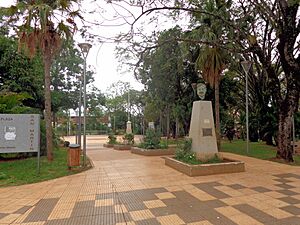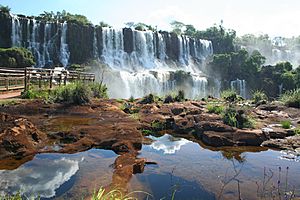Puerto Iguazú facts for kids
Quick facts for kids
Puerto Iguazú
|
|
|---|---|

Avenida Aguirre, one of the main avenues in Puerto Iguazú
|
|
| Country | |
| Province | |
| Department | Iguazú |
| Elevation | 162 m (531 ft) |
| Population
(2010 census [INDEC])
|
|
| • Total | 82,227 |
| Time zone | UTC−3 (ART) |
| Website | http://www.iguazu.gob.ar/ |
Puerto Iguazú is a lively city located in the Misiones region of Argentina. It sits right on the border, making it a special place where Argentina meets other countries.
With a population of about 82,000 people (as of 2010), it's one of the biggest cities in Misiones. But what really makes Puerto Iguazú famous are the incredible Iguazú Falls. These giant waterfalls are only about 18 kilometers (11 miles) away! Because of the falls, the city is a major hub for tourists from all over the world.
Contents
Discovering Puerto Iguazú's Past
How the City Began
The amazing Iguazú Falls were first seen by a European explorer named Álvar Núñez Cabeza de Vaca in 1542. He heard the loud roar of the water from many kilometers away! At that time, the Guaraní people were the main inhabitants of this area.
Even after this early discovery, the land around the falls remained mostly home to the Guaraní people until the 1880s. The area was part of the Corrientes Province back then. In 1881, a large piece of land where Puerto Iguazú now stands was sold.
This land changed owners a few times before it belonged to Gregorio Lezama. He sent explorers to check out the area. These explorers, Carlos Bosetti and Jordan Hummel, later led the very first tourist trip to the falls!
Founding the Town
In 1882, the Iguazú Department was created as one of the first areas in Misiones. A local judge, Alberto Mujica, was assigned to the area in 1897. Around this time, the first hotel opened to welcome the growing number of visitors to Iguazú Falls.
A kind person named Victoria Aguirre helped fund the first road into the town in 1901. She also supported other improvements for the community. Because of her help, the settlement was officially named Puerto Aguirre on September 10, 1902. Over the next few years, a police department, a civil registrar, and a post office were added.
A New Name and a Bridge
The beautiful Iguazú National Park was officially created by the government in 1934. Then, in 1943, the town's name was changed to Puerto Iguazú.
A very important bridge, the Tancredo Neves Bridge, was opened in 1985. This bridge connects Puerto Iguazú with a nearby city in Brazil called Foz do Iguaçu.
Exploring Puerto Iguazú's Climate
Weather in Puerto Iguazú
Puerto Iguazú has a Humid Subtropical climate. This means it has warm winters and hot summers. There's no dry season here, so it rains a lot throughout the year. Every month gets more than 100 millimeters (4 inches) of rain, and November is usually the wettest month, with over 200 millimeters (8 inches) on average.
Most of the rain comes from big convective storms. Because of all this rain, rainforests grow all around Puerto Iguazú.
Hot and Cool Seasons
The hot season in Puerto Iguazú can last for six months or even longer. During this time, temperatures often reach between 30 and 35 degrees Celsius (86-95°F) during the day. At night, temperatures usually drop to 18 to 24 degrees Celsius (64-75°F). When it gets too hot, thunderstorms with heavy rains help cool things down.
The cool season runs from late April to mid-September. In June, the average daily high is around 21 degrees Celsius (70°F), and the low is about 11 degrees Celsius (52°F). The weather can change quickly. Some days are warm with northerly winds, reaching 28 degrees Celsius (82°F) or more. Then, suddenly, it can become cool and rainy, with temperatures between 10 and 15 degrees Celsius (50-59°F). After that, it might be sunny and dry, with colder nights around 5 degrees Celsius (41°F) or even lower.
It doesn't freeze very often, but it can happen in some winters. Temperatures close to freezing occur every winter. The lowest temperature ever recorded was -4.9 degrees Celsius (23.2°F). Sometimes, temperatures can even go above 40 degrees Celsius (104°F) in spring and summer!
| Climate data for Puerto Iguazú (International Airport), Argentina 1991–2020, extremes 1961–present | |||||||||||||
|---|---|---|---|---|---|---|---|---|---|---|---|---|---|
| Month | Jan | Feb | Mar | Apr | May | Jun | Jul | Aug | Sep | Oct | Nov | Dec | Year |
| Record high °C (°F) | 40.6 (105.1) |
39.0 (102.2) |
38.5 (101.3) |
35.2 (95.4) |
32.5 (90.5) |
32.0 (89.6) |
31.9 (89.4) |
35.6 (96.1) |
40.0 (104.0) |
40.1 (104.2) |
39.9 (103.8) |
40.0 (104.0) |
40.6 (105.1) |
| Mean daily maximum °C (°F) | 32.0 (89.6) |
31.5 (88.7) |
30.6 (87.1) |
27.8 (82.0) |
23.5 (74.3) |
22.2 (72.0) |
22.5 (72.5) |
25.2 (77.4) |
26.8 (80.2) |
28.7 (83.7) |
30.1 (86.2) |
31.3 (88.3) |
27.7 (81.9) |
| Daily mean °C (°F) | 25.8 (78.4) |
25.2 (77.4) |
24.3 (75.7) |
21.6 (70.9) |
17.8 (64.0) |
16.5 (61.7) |
15.9 (60.6) |
17.9 (64.2) |
19.9 (67.8) |
22.4 (72.3) |
23.7 (74.7) |
25.2 (77.4) |
21.3 (70.3) |
| Mean daily minimum °C (°F) | 20.7 (69.3) |
20.4 (68.7) |
19.4 (66.9) |
16.9 (62.4) |
13.4 (56.1) |
12.2 (54.0) |
11.0 (51.8) |
12.3 (54.1) |
14.3 (57.7) |
17.0 (62.6) |
17.9 (64.2) |
19.8 (67.6) |
16.3 (61.3) |
| Record low °C (°F) | 9.0 (48.2) |
7.6 (45.7) |
6.5 (43.7) |
0.7 (33.3) |
−3.3 (26.1) |
−2.2 (28.0) |
−4.8 (23.4) |
−4.9 (23.2) |
−1.4 (29.5) |
2.9 (37.2) |
5.6 (42.1) |
3.9 (39.0) |
−4.9 (23.2) |
| Average precipitation mm (inches) | 180.1 (7.09) |
149.9 (5.90) |
153.3 (6.04) |
161.1 (6.34) |
185.5 (7.30) |
145.5 (5.73) |
107.0 (4.21) |
83.7 (3.30) |
155.3 (6.11) |
247.0 (9.72) |
172.3 (6.78) |
219.0 (8.62) |
1,959.7 (77.15) |
| Average precipitation days (≥ 0.1 mm) | 10.0 | 9.6 | 8.7 | 8.2 | 8.9 | 8.5 | 8.1 | 6.4 | 9.2 | 12.2 | 9.1 | 10.3 | 109.1 |
| Average relative humidity (%) | 79.0 | 80.5 | 80.9 | 83.8 | 87.5 | 88.6 | 85.0 | 78.9 | 77.0 | 78.8 | 75.8 | 77.9 | 81.1 |
| Mean monthly sunshine hours | 201.5 | 183.6 | 173.6 | 168.0 | 130.2 | 111.0 | 139.5 | 170.5 | 132.0 | 161.2 | 198.0 | 189.1 | 1,958.2 |
| Mean daily sunshine hours | 6.5 | 6.5 | 5.6 | 5.6 | 4.2 | 3.7 | 4.5 | 5.5 | 4.4 | 5.2 | 6.6 | 6.1 | 5.4 |
| Percent possible sunshine | 47 | 45 | 45 | 45 | 40 | 35 | 39 | 38 | 29 | 43 | 47 | 49 | 42 |
| Source 1: Servicio Meteorológico Nacional | |||||||||||||
| Source 2: UNLP (percent sun 1971–1980) | |||||||||||||
What Drives Puerto Iguazú's Economy?
Tourism and Jobs
The main engine of Puerto Iguazú's economy is tourism. The city has many hotels, which provide most of the jobs for the people living there. Many new international hotels have been built, and more are still being constructed along the banks of the Iguazú River.
Fun Places to Visit
Besides the amazing Iguazú Falls, there are many other cool places to visit in the area:
- Three Frontiers: This is a unique spot where the borders of Argentina, Paraguay, and Brazil all meet!
- Artisan Community: Puerto Iguazú has a lively community of artists who create beautiful crafts.
- La Aripuca resort: A special place built with huge tree trunks, showing how important nature is.
- Museum of Images of the Jungle: This museum has a collection of amazing woodcarvings.
- Mbororé Museum: Learn about the history of the region.
- Luis Honorio Rolón Municipal Nature Park: A great place to enjoy nature.
- Güira Oga Center for Bird Rehabilitation: A center that helps injured birds get better.
Exploring the Wanda Mines
Just a short distance from the city are the Wanda Mines. These mines are a popular spot for people who love collecting gemstones and geodes. They have been operating since the 1950s. Here, you can find some of Argentina's best agate, amethyst, quartz, and topaz stones.
Getting Around Puerto Iguazú
The Tancredo Neves International Bridge connects Puerto Iguazú with the Brazilian border town of Foz do Iguaçu. This bridge is where Argentina's National Route 12 turns into Brazil's BR-469.
From the main bus station in Puerto Iguazú, you can easily take taxis or a local bus. One bus route goes from the Three Frontiers area all the way to Iguazú National Park, where the waterfalls are!
The city has its own airport, Cataratas del Iguazú International Airport. You can also use the Foz do Iguaçu International Airport on the Brazilian side of the border.
Nature and Wildlife in Puerto Iguazú
The Iguazú National Reserve
The area around Puerto Iguazú is home to the 12,620-hectare Iguazú National Reserve, which was created in 1970. This reserve helps protect the amazing nature here.
Plants and Animals
One of the last parts of the Atlantic Forest can be found in and around the Iguazu Falls. This is a subtropical forest with native bamboos and many different kinds of birds, including colorful toucans and tiny hummingbirds.
You might also see coatis, which are small animals that are used to visitors and sometimes beg for food. Many of the streets in Puerto Iguazú are made of red dirt, with grassy ditches on the sides. These ditches are home to eels and various freshwater fish, like knifefish and catfish. All these small canals eventually drain into the Paraná River.
Sister Cities
Puerto Iguazú has special connections with two cities in Paraguay:
- Ciudad del Este, Paraguay
- Presidente Franco, Paraguay
Images for kids
See also
 In Spanish: Puerto Iguazú para niños
In Spanish: Puerto Iguazú para niños








